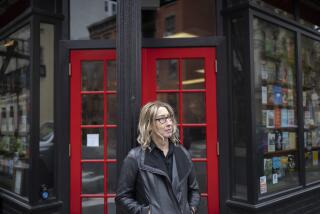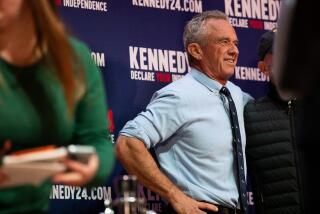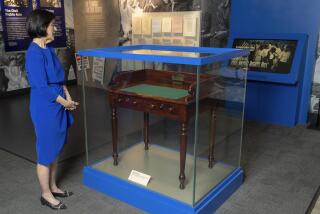Nixon Library Marketers Elect Light Approach
YORBA LINDA — It’s not easy for a former U.S. President to run against Mickey Mouse. So Richard Nixon Library campaigners have fought fun with fun, positioning their candidate as an alternative Happiest Place on Earth.
A series of newspaper advertisements have beckoned visitors to the year-old library with light-hearted rhetoric. One ad featured the National Archives’ most requested photograph--Nixon and Elvis Presley posing with hands clasped in the Oval Office. “The President and the King,” the flashy notice read.
Days after the failed coup in the Soviet Union, library marketers capitalized on Nixon’s trip to the country earlier this year, showcasing a picture of him with Mikhail S. Gorbachev. “They’re back! Gorbachev in Moscow and Nixon in Yorba Linda,” proclaimed the ad.
Another ad, apparently making a tongue-in-cheek reference to the Watergate scandal that forced Nixon’s resignation in 1974, displayed a photo of the fallen President gesturing in animated dialogue. “Now you can put Nixon on the spot,” it promised.
The whimsical advertisements, flamboyant in contrast with the serious atmosphere of presidential libraries, reflect the attraction’s struggle to survive in an area saturated with glitzier distractions. And some presidential scholars wonder if the ads tarnish, rather than enhance, the former President’s image.
“They seem to treat Nixon as a camp figure,” said Mark Petracca, an assistant professor of political science at UCI.
The goal of the ads is to beef up attendance--which has lagged far behind the 500,000-visitor-a-year estimate projected at the time of the library’s groundbreaking in 1988. Last year, officials claimed that the newborn library was bringing in about 1,000 sightseers a day, but they since have become tight-lipped about attendence figures.
Most presidential libraries are run by the federal government and have the safety net of taxpayer dollars. Because the privately funded Nixon Library relies solely on its $4.95 admission fee, gift shop sales and donations, healthy attendance figures are a must. “That’s why we take a high profile in promoting ourselves,” said John Taylor, director of the Richard Nixon Library & Birthplace.
Library officials view Disneyland as their direct competitor--the world-famous Magic Kingdom a looming presence that brightly colors their advertising tactics.
“There are a lot of exciting places in Southern California vying for three hours of the public’s time on a Sunday afternoon,” Taylor said. “With the possible exception of the (John F. Kennedy) Library in Boston, no other presidential library is in an area so densely packed with tourist attractions.”
Sandy Quinn, the library’s marketing consultant who helped create the ads, said that they are “a recognition of the sophisticated tourist market in Southern California.”
Quinn’s background underscores library marketers’ us-against-them approach. For years, he worked as a consultant for Walt Disney World in Orlando, Fla.
“We wanted to use visuals that would make our ad stand out on a page full of ads,” he said. “In the beginning, we have to build awareness so that people will think of us when they have discretionary time.
“And look at Disneyland--it’s still running full-page ads 36 years after it opened.”
Taylor sees the delineation of library as a handicap in romancing a population wooed by roller coasters, sun and beaches. The “upbeat ads,” he said, are meant “to show people that if they come here they won’t just find rows and rows of books.”
“To sustain the archival role of the library, we have to succeed first of all as an attraction,” explained Taylor, who said he has not received any feedback from the former President about the ads.
Not only is the word library hard to sell as entertainment, so too is the word Nixon, said David Stewart, professor of marketing at USC.
“Richard Nixon was never known for his sense of humor,” Stewart said. “On top of that, most people perceive presidential libraries as boring. I imagine that the ads are trying to break down that perception. They’re humorous, but they’re respectfully humorous.”
UCI’s Petracca has a different opinion of the ads. “They’re rather demeaning,” he said. “I think this advertising binge is a way to turn the Nixon Library into pop culture. It might not be too long before the library has kiddy rides. I’m imagining a carousel with the images of Mao Zedong, (Henry) Kissinger and Nixon spinning around.”
Jean Craig, president of the Kresser/Craig advertising agency in Santa Monica, agreed that the ads cast their subject in an unstatesmanlike light. “In my personal opinion, we should give an ex-President of the United States a little more dignity than that,” she said.
One of the ads--”Put Nixon on the Spot”--seems to playfully mock the former President, said Nixon biographer Stephen Ambrose, director of the Eisenhower Center at the University of New Orleans.
“Then again, Nixon has always had a marvelous ability to use any asset he has, and one of his assets since August of ’74 has been that he’s the only President to have resigned--and he does use that asset quite effectively,” Ambrose said. “(The ad) is just Nixon being Nixon.”
That ad promoted the library’s “Presidential Forum”--an interactive video exhibit that allows visitors to select questions from a computer monitor and hear Nixon respond on a large video screen.
The video is “our answer to ‘Great Moments With Lincoln,’ ” Quinn said, referring to a longtime Disneyland attraction.
One strategy of the ad campaign, Ambrose said, might be to extend a hand to people who harbor ill feelings toward Nixon. “There are a lot of folks out there who still hate him,” Ambrose said.
“The hope could be that once those people see the library and are reminded of things like detente, they might come out with a more balanced view of Nixon,” Ambrose said. “There’s more to Nixon than just Watergate.”
Still, he added, “I can’t imagine any other presidential library promoting itself with a photo of Elvis Presley.”
That’s partly because the other libraries, except the privately owned Rutherford B. Hayes Library in Fremont, Ohio, are government-financed and operated institutions. “Each library has a private foundation that funds special exhibits and symposiums,” said Jill Brett, a spokeswoman for the National Archives, which oversees the eight public libraries. “All advertising is paid for by the foundations.”
The Lyndon B. Johnson Library did no advertising at all during its first year in 1971. “We had so much press that we didn’t need to,” recalled Larry Reed, assistant director of the Lyndon B. Johnson Foundation in Austin, Tex.
Today the foundation occasionally runs ads for various events at the library, which draws about 450,000 visitors annually and has free admission. “But we’ve never done anything in a humorous vein,” Reed said.
Like the Nixon Library, the Dwight D. Eisenhower Library in Abilene, Kan., has aimed to broaden its audience recently.
“We appeal mostly to elderly people because Eisenhower was a World War II hero,” said Colleen Cearley, public affairs specialist for the library, which has about 150,000 visitors a year at $1.50 admission. “Lately we’ve been trying to pull in a wider range age-wise.”
To commemorate what would have been Eisenhower’s 100th birthday last year, private foundations sponsored a ‘50s film festival and a sock hop intended to attract younger people. The library promoted the festive events with a number of paid ads. “We appreciate humor, but we haven’t used it yet in our advertising,” Cearley said.
Quinn, marketing consultant for the Nixon Library, hopes the ad campaign sparks bipartisan interest in the attraction. “We’re not exclusive to supporters,” he said.
But, Quinn emphasized, the ads are meant to maximize attendence--not minimize Nixon.
“If they in any way poked fun,” he said, “we wouldn’t have run them.”
More to Read
The biggest entertainment stories
Get our big stories about Hollywood, film, television, music, arts, culture and more right in your inbox as soon as they publish.
You may occasionally receive promotional content from the Los Angeles Times.










